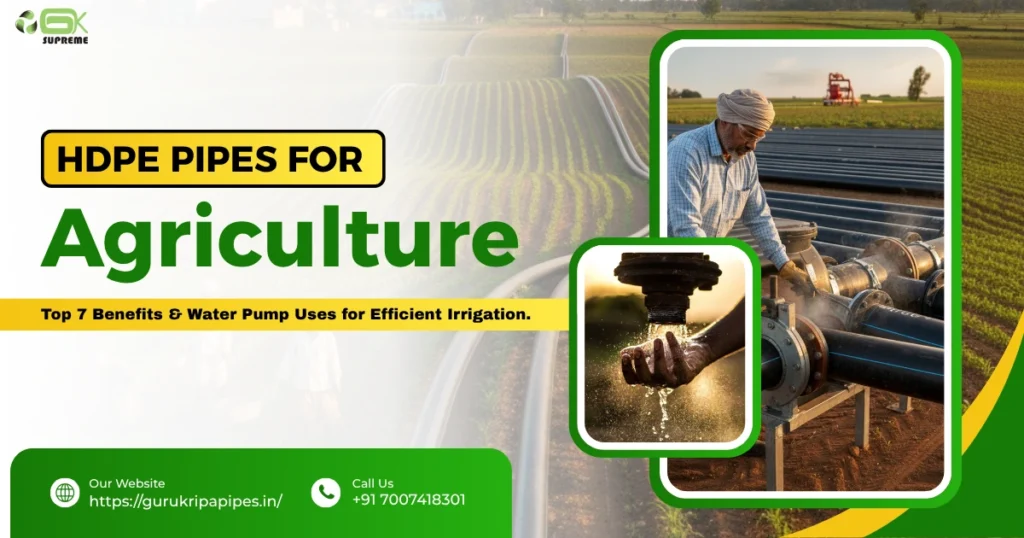Water management is one of the most critical factors in modern farming. Ensuring a steady and efficient water supply can make the difference between a healthy crop yield and wasted resources. This is where HDPE pipes for agriculture play a pivotal role. Designed to deliver water reliably, these pipes are transforming irrigation systems and helping farmers optimize water usage.
Farmers across the globe are increasingly choosing HDPE pipes for agriculture because of their durability, flexibility, and resistance to chemicals and corrosion. Whether it’s for drip irrigation, sprinkler systems, or connecting a pump for water, these pipes provide an efficient and cost-effective solution.
One of the key reasons HDPE pipes for agriculture are preferred is their leak-proof design, which ensures minimal water wastage and maximum efficiency in water delivery. Additionally, their lightweight construction and ease of installation make them ideal for farms of all sizes.
By integrating HDPE pipes for agriculture into your irrigation setup, you can not only save water and energy but also ensure long-term reliability for your farm’s water distribution system. In this article, we will explore the top 7 benefits of using HDPE pipes for agriculture and how they can enhance your irrigation and water management systems.
In this article, we explore the HDPE Pipes for Agriculture: Top 7 Benefits and Water Pump Uses, their uses, installation tips, and maintenance guidelines.
If you’re looking for high-quality HDPE pipes for agriculture, Gurukripa Pipes is your trusted partner. Their range of durable and leak-proof pipes ensures efficient water distribution across farms, supporting both large-scale and small-scale irrigation projects. With a focus on reliability, Gurukripa Pipes offers products that withstand harsh environmental conditions and chemical exposure, making them ideal for all agricultural applications.
What is HDPE / High Density Polyethylene Pipe?
HDPE stands for High Density Polyethylene, a thermoplastic polymer made from ethylene. It is widely used in manufacturing durable and flexible pipes suitable for a range of applications.
Key Features of HDPE Pipes:
- High tensile strength – withstands pressure and stress
- Flexibility – can bend and absorb ground movement
- Corrosion resistance – unaffected by chemicals or rust
- Long lifespan – typically 50–100 years
- Smooth internal surface – reduces friction, improving water flow
- Lightweight – easy to handle and install
These qualities make HDPE pipes an ideal solution for irrigation systems, water supply lines, and agricultural applications.
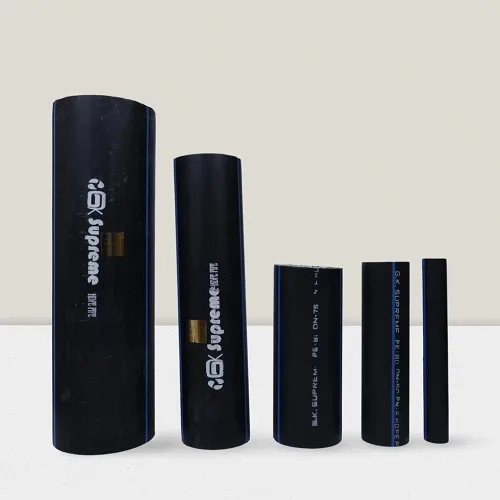
Why HDPE Pipes Are Ideal for Agriculture & Irrigation
Agricultural environments can be harsh, with soil movement, chemical exposure, and heavy equipment. Many traditional pipes like PVC or metal struggle under these conditions, leading to leaks, damage, and inefficiency.
HDPE pipes offer:
- Resistance to UV rays, chemicals, and corrosion
- Leak-proof joints through fusion welding
- Flexibility to withstand soil and environmental stress
- Compatibility with various water pumps for efficient irrigation
Farmers and agricultural businesses relying on pumps for water can benefit greatly from Gurukripa’s HDPE pipes. Designed for smooth flow and minimal friction loss, these pipes help maximize irrigation efficiency while reducing energy consumption. Whether you are setting up drip irrigation, sprinkler systems, or connecting mainlines to water sources, Gurukripa Pipes provides the right solution to optimize water usage.
Top 7 Benefits of HDPE Pipes for Agriculture
1. Leak-Proof Joints
They are fused together using butt fusion, socket fusion, or electrofusion, creating a joint as strong as the pipe itself. This eliminates water loss at connection points and ensures a more efficient irrigation system.
2. Flexibility and Fatigue Resistance
It can bend without cracking, accommodating uneven terrain and minor soil shifts. This reduces the number of fittings required and prevents joint failures under pressure changes.
3. Durability and Long Lifespan
With a typical service life of 50–100 years, HDPE pipes outlast many traditional materials. This reduces replacement costs and long-term maintenance.
4. Chemical and Corrosion Resistance
Agriculture exposes pipes to fertilizers, pesticides, and other chemicals. They are chemically inert, preventing corrosion and maintaining water quality.
5. Hydraulic Efficiency
The smooth interior of HDPE pipes reduces friction, allowing water to flow efficiently. This reduces pump energy consumption and ensures consistent water supply across fields.
6. Temperature and Environmental Resistance
HDPE pipes withstand temperature fluctuations, UV exposure, and minor freeze-thaw conditions. They also absorb soil stress without cracking, making them ideal for outdoor irrigation systems.
7. Lightweight and Easy to Install
HDPE pipes are light, easy to transport, and require minimal labor for installation. Fewer fittings and trenching reduce costs, making them economical despite a higher initial price HDPE Pipe Uses in Agriculture
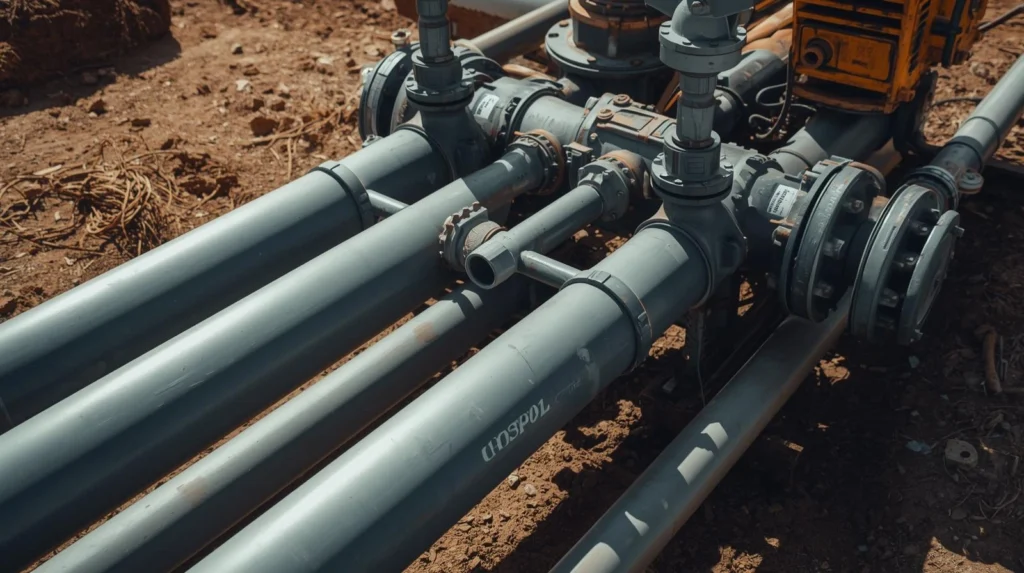
HDPE Pipe Uses in Agriculture
Now that we understand the benefits, let’s see how hdpe pipe uses manifest in real agricultural scenarios.
A. Mainline & Distribution Lines
HDPE pipes serve as trunk lines from the water source (pond, well, reservoir) to fields. Their large diameters, leak-free joints, and low friction make them ideal for high-volume conveyance.
B. Lateral Lines for Irrigation
Branching from the mainlines, HDPE works in drip irrigation, sprinkler lines, and micro-irrigation systems. Its flexibility helps route pipes over varied terrain without too many fittings.
C. Livestock Watering Systems
To carry water from tanks or pumps to troughs, HDPE ensures clean, durable water delivery with minimal maintenance.
D. Pump Connections & Delivery Lines
HDPE pipes connect directly to pumps. Because of low friction and stable pressure, they make efficient conduits for pumping water across distances.
E. Greenhouse & Controlled Environment Systems
In horticulture or greenhouse projects, HDPE lines deliver precise water amounts with minimal leakage — critical in such controlled systems.
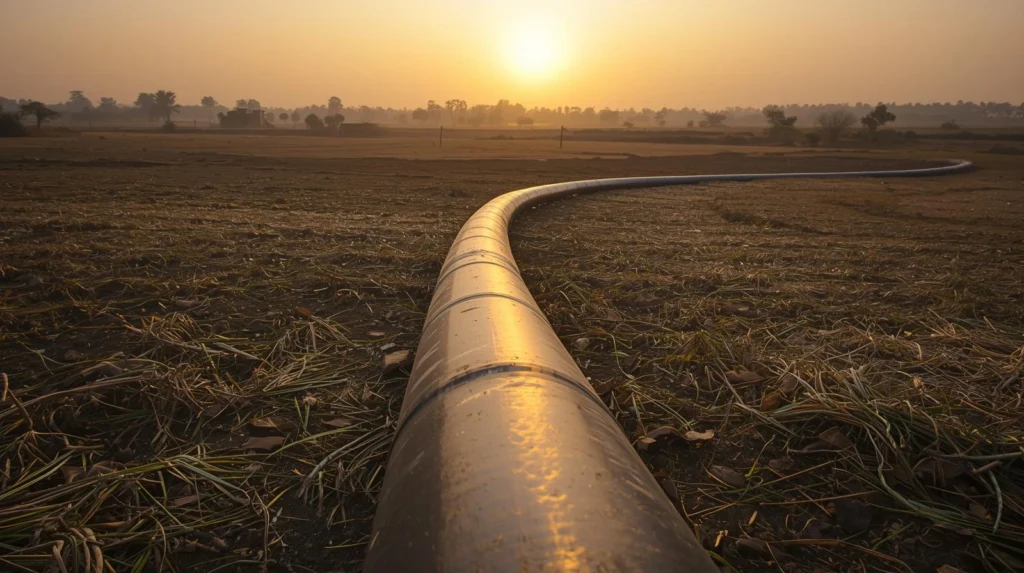
Selecting & Installing HDPE Pipes with Water Pumps
Even the best pipes need correct design and installation to perform well. Here are guidelines:
a) Sizing & Pressure Rating
- Choose appropriate diameter and wall thickness (pressure class) based on flow rate, head, and pump capacity.
- Leave margin for future expansion.
- Use HDPE pressure-rated pipes (PE80, PE100, etc.) suited for irrigation.
b) Compatibility With Pumps
- Ensure pump outlets/adapters suit HDPE diameters.
- Use proper fittings or adaptors (e.g. transition couplers) to connect pump to HDPE lines.
- The junction should maintain smooth flow (avoid sudden valves, restrictions).
c) Proper Jointing & Welding
- Use trained personnel for butt fusion, socket fusion, or electrofusion.
- Follow manufacturer’s guidelines (temperature, cooling time, pressure).
- Clean pipe ends before welding.
- Record joint logs for quality assurance.
d) Trenching & Bedding
- Lay the pipes in well-prepared trenches with sand/graded bedding for support.
- Avoid sharp rocks against pipes.
- Leave slack loops or allowances for expansion in long runs.
e) Protection & Anchoring
- For pump areas or sharp bends, provide anchors or thrust blocks.
- Use protective wrapping or sleeves in zones of mechanical stress or exposure.
f) Priming, Flushing, & Testing
- After installation, flush the lines to remove debris.
- Pressure test at 1.5× rated pressure to check for leaks (per standards).
- Document all test data.
g) Integration With Control Systems
- Use valves, sensors, flow meters, and automation to regulate water delivery.
- The smooth flow of HDPE helps achieve stable sensor readings.
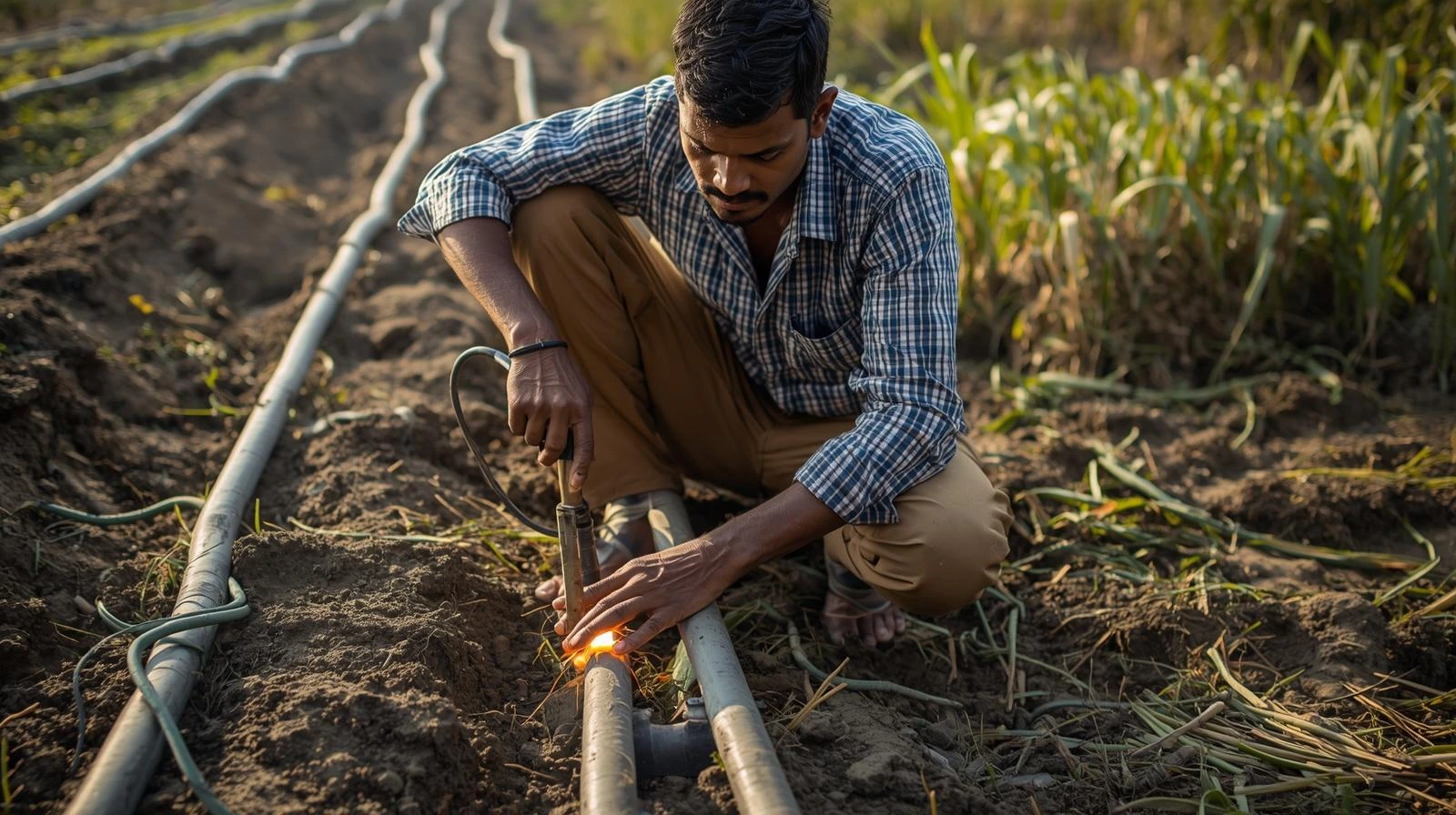
Maintenance, Challenges & Best Practices
Maintenance Tips
- Visually inspect accessible lines for damage or exposure.
- Monitor pressure drops or flow anomalies (could indicate internal clog or hidden leak).
- Repair by cutting out faulty section and fusion-weld new piece.
- Flush lines periodically to remove sediments.
Challenges / Considerations
- Weld joints require skilled labor — bad joints can fail.
- In extremely cold climates, draining may still be necessary.
- Soil shifts or heavy machinery can damage exposed sections if not protected.
- UV exposure over decades needs proper carbon-black stabilization.
Best Practices
- Use qualified installers.
- Maintain joint logs.
- Use protective measures in high-risk areas (rocks, traffic).
- Plan for expansion or future piping changes in layout.
- Keep spare pieces and fittings on hand.
Environmental and Economic Benefits
Environmental:
- Water conservation through leak-free systems
- Reduced energy use due to lower friction
- Recyclable material reduces environmental impact
Economic:
- Lower maintenance and replacement costs
- Energy savings via efficient pumps
- Improved crop yields due to reliable irrigation
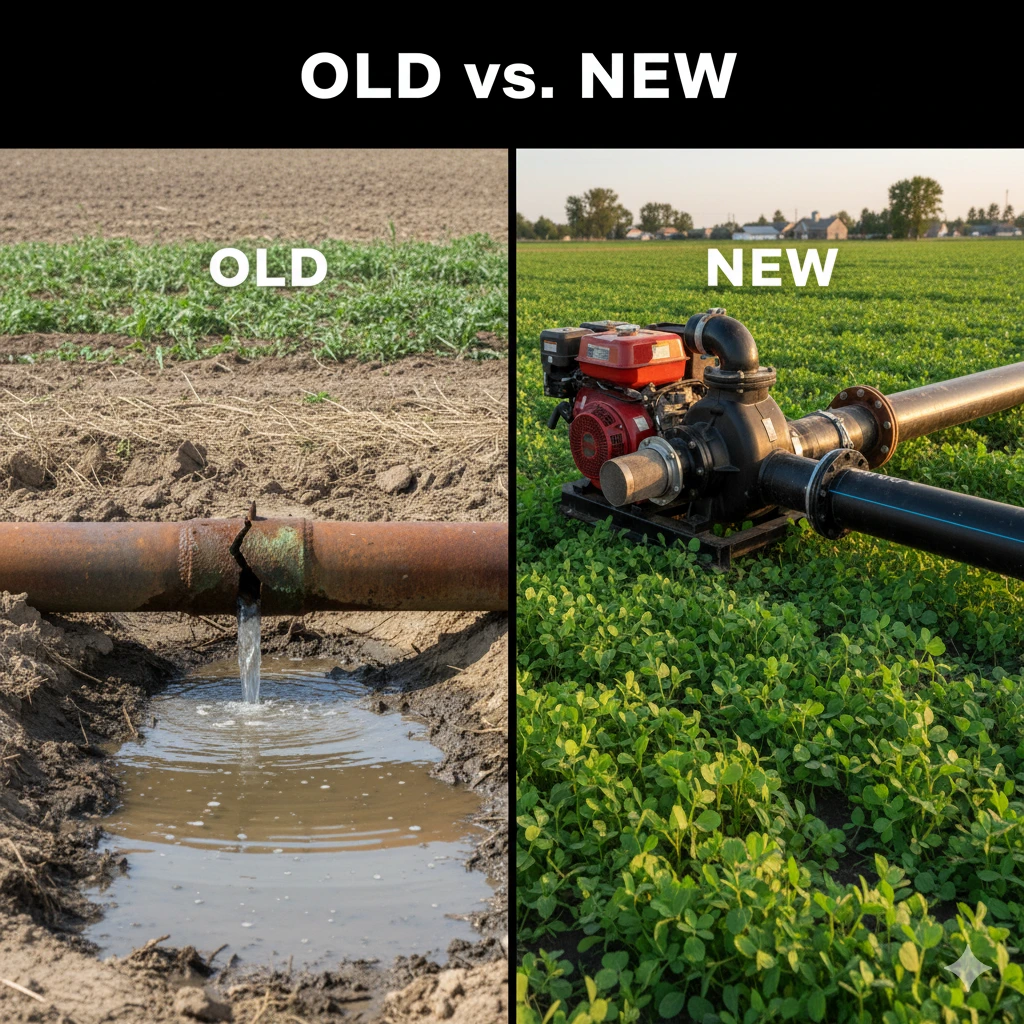
Conclusion
HDPE pipes for agriculture and irrigation systems worldwide. Their leak-proof joints, durability, flexibility, and resistance to chemicals make them ideal for water delivery systems connected to pumps for water.
With years of experience in manufacturing HDPE pipes for agriculture, Gurukripa Pipes combines advanced technology with stringent quality control to ensure long-lasting performance. By choosing their products, you not only invest in a reliable irrigation system but also enhance crop yield and sustainability. Check out their range today at https://gurukripapipes.in/ and upgrade your farm’s water management system effortlessly.
Investing in HDPE pipes ensures efficient, reliable, and cost-effective irrigation for decades, boosting both productivity and sustainability.
Q1. Are HDPE pipes better than PVC for agriculture?
Yes. HDPE pipes offer better flexibility, leak resistance, and durability.
Q2. How long do HDPE pipes last?
Typically 50–100 years depending on conditions
Q3. Can HDPE pipes handle high pump pressures?
Yes, with proper pressure-rated pipes (PE80, PE100).
Q4. Do I need special tools for HDPE pipe installation?
Yes. Fusion welding tools are required.
Q5. Can HDPE pipes freeze?
They are resistant but still recommended to drain in extreme cold.
Q6. Are HDPE pipes cost-effective?
Yes, due to long lifespan, water savings, and low maintenance costs.

